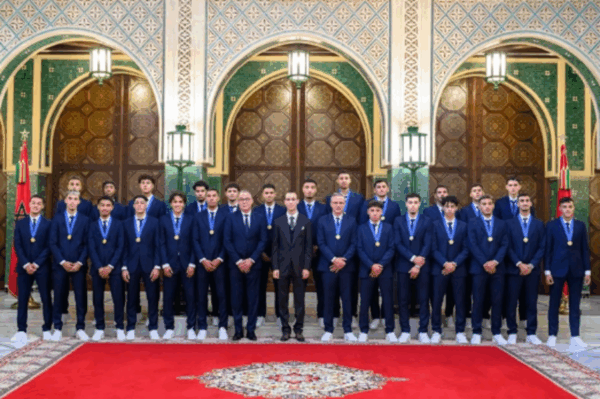By Dr. Mohamed H’Midouche, Executive Vice President of the African Diplomatic Academy & Honorary Consul of Cape Verde in Morocco.
On Wednesday, October 22, 2025, in Rabat, Morocco proudly celebrated its U-20 world champions, who achieved a historic feat at the 2025 World Cup in Chile. Upon their return to the country, the young Lions of the Atlas were welcomed with exceptional popular jubilation: thousands of Moroccans from all regions gathered along Mohammed V Avenue in the capital to greet their heroes. The highlight was the royal reception at the Rabat Palace, hosted by His Majesty King Mohammed VI and presided over by HRH Crown Prince Moulay El Hassan, in the presence of the president of the FRMF, Fouzi Lekjaa, the technical staff, and the players.
This tribute illustrates the symbiosis between the Throne, the youth, and the Moroccan people, as well as the royal interest in promoting merit, excellence, and national cohesion. It is in this context that the following analysis is presented: twenty years of transformation to elevate Morocco to the top of the world.
A royal vision, foundation of the Moroccan model
Under the impetus of His Majesty King Mohammed VI, Morocco has made sport a strategic lever for human, economic, and diplomatic development. This vision is based on four pillars:
- modernization of infrastructure;
- training and early talent detection;
- federal governance and professionalization;
- African sports diplomacy and cultural soft power.
Inaugurated in Salé in 2010, the Mohammed VI Academy embodies the transformation of Moroccan football. It combines sporting excellence and civic education: national detection, dual study/sport path, medical monitoring, mental preparation, and high-level coaching. Internationals like Youssef En-Nesyri, Azzedine Ounahi, Nayef Aguerd, or Hamza Mendyl have emerged from it. “The Academy does not only train players: it shapes men aware of their mission.”
Inaugurated in 2019, on 30 hectares, the Mohammed VI Maâmoura Complex brings together FIFA-approved fields, a medical & rehabilitation center, data analysis, accommodations for A/U23/U20/women’s teams, and training for professionals (coaches, referees). Compared to Clairefontaine (France) or St. George’s Park (England), the Complex is the headquarters of Moroccan performance.
The successes of Doha 2022 and Santiago 2025 are based on: royal vision and state continuity; stabilized federal governance; scientific preparation; patriotism and collective culture. “Morocco has made sporting performance a national project.”
The epic of Mexico 1970 (Morocco’s first participation in the World Cup) shaped the national DNA. Ahmed Faras (African Ballon d’Or 1975) and Hammadi Hamidouch instilled an ethic: rigor, humility, national duty. “The Faras and the Hamidouch have shaped the soul of Moroccan football.”
Walid Regragui led the Lions of the Atlas to the semi-finals of Doha 2022. Mohamed Ouahbi, on the other hand, gave Morocco its first U-20 world title in Santiago 2025. Two paths that consecrate national competence and the Moroccan school of sports leadership.
Faithful to its pan-African vocation, Morocco makes its stadiums and infrastructure available to CAF and several African nations. “Africa progresses when its nations advance together.”
Built according to FIFA and CAF standards, the new Prince Moulay Abdellah Stadium symbolizes modern Moroccan sports. Its inaugural match on September 5, 2025, between Morocco and Niger, confirmed its full compliance with international standards. Alongside the Grand Stadium of Benslimane, still under construction, it forms the foundation for the preparation of the 2030 World Cup. “Present and future converge in the architecture of success.”
Established in 2025, the Morocco 2030 Foundation oversees the organization of the 2025 AFCON and the 2030 World Cup: planning, infrastructure, sustainability, territorial development, financial governance, and international influence. The FRMF orchestrates the technical pipeline for a competitive national team in 2030, while integrating the 2025 champion U-20 generation.
The organization of major competitions represents an economic, social, and diplomatic lever for Morocco. Sport becomes a cross-cutting economic sector activating transportation, tourism, handicrafts, media, advertising, finance, and technology.
Broadcasting rights and sponsorship enhance investment and training capacities. Morocco attracts global partners like TotalEnergies, Royal Air Maroc, Coca-Cola, Adidas, Visa, or Orange.
Since 2024, Morocco has launched the “Visit Morocco” campaign, using sport as a vector for tourist and cultural promotion. “Football becomes an ambassador of the territory.”
According to FMPS, sport represents approximately 1.56% of the national GDP (21 billion MAD, 11,500 direct jobs) and over 2.5% of the GDP with the public and associative sector (115,000 jobs). The impact includes tourism, employment, image, and soft power.
Sport is also a strategic research sector for universities and innovation centers. “Sport is a laboratory for development and a mirror of society.”
Conclusion
Morocco has turned sport into a national project: education, infrastructure, governance, diplomacy, and economy mutually reinforce each other. From Doha 2022 to Santiago 2025 and towards 2030, the Kingdom asserts a signature: excellence, African solidarity, and sustainable vision. “Morocco not only produces champions; it shapes symbols, leaders, and a nation in motion.”


